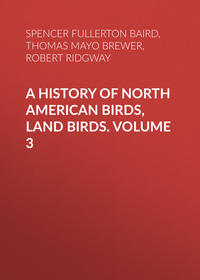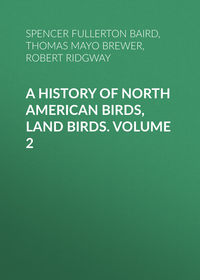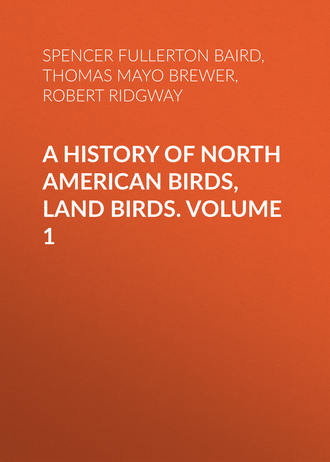 полная версия
полная версияA History of North American Birds, Land Birds. Volume 1
Mr. Sumichrast describes its nest29 as very skilfully wrought with spiders’ webs, and built in the crevices of old walls, or in the interstices between the tiles under the roofs of the houses. A nest with four eggs, supposed to be those of this species, was obtained in Western Texas by Mr. J. H. Clark; it was cup-shaped, not large, and with only a slight depression. The eggs, four in number, were unusually oblong and pointed for eggs of this family, and measured .80 by .60 of an inch, with a crystalline-white ground, profusely covered with numerous and large blotches of a reddish or cinnamon brown.
So far as the observations of Mr. Ridgway enabled him to notice this bird, he found it much less common than the Salpinctes obsoletus, and inhabiting only the most secluded and rocky recesses of the mountains. Its common note of alarm is described as a peculiarly ringing dīnk. It has a remarkably odd and indescribably singular chant, utterly unlike anything else Mr. Ridgway ever heard. This consisted of a series of detached whistles, beginning in a high fine key, every note clear, smooth, and of equal length, each in succession being a degree lower than the preceding one, and only ending when the bottom of the scale is reached. The tone is soft, rich, and silvery, resembling somewhat the whistling of the Cardinal Grosbeak.
It was often seen to fly nearly perpendicularly up the face of a rocky wall, and was also noticed to cling to the roof of a cave with all the facility of a true Creeper.
Genus THRYOTHORUS, VieillThryothorus, Vieillot, Analyse, 1816, 45. (Type, Troglodytes arundinaceus, “Troglodyte des Roseaux,” Vieill. Ois. Am. Sept. II, 1807, 55 = Sylvia ludoviciana, Lath.)
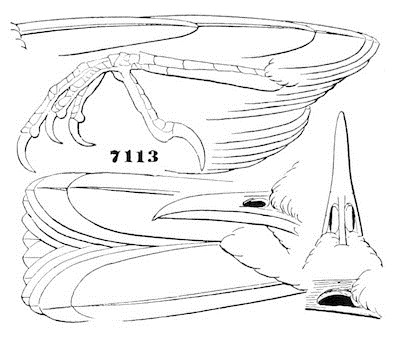
Thryothorus ludovicianus.
7113
Gen. Char. Bill compressed, rather slender; height about one fourth the length above. Culmen and commissure gently curved throughout; gonys straight; tip very obsoletely notched. Nostrils in the lower edge of anterior extremity of the nasal groove, narrowly elliptical, overhung by a stiff scale-like roof of the thickened membrane of the upper part of the nasal groove, the crescentic edge rounded. The septum of nostrils imperforate; the posterior part of the nasal cavity with a short septum projecting into it parallel with the central, not perpendicular as in Microcerculus. Wings and tail about equal, the latter moderately rounded; the first primary more than half the second, about half the longest. Tarsi rather short, scarcely exceeding middle toe. Anterior scutellæ distinct, rest of each side of tarsi in a continuous plate. Lateral toes equal.
The diagnoses of the North American species are as follows:—
Species and VarietiesCommon Characters. Head above, and back, of much the same color. Crissum barred transversely; rest of under parts plain. Upper tail-coverts and exposed surface of wings barred. Iris hazel. Nest in holes or with an arched covering. Eggs reddish-white, spotted with red and purple.
a. ThryothorusT. ludovicianus. Tail-feathers reddish-brown, barred with black. Greater wing-coverts spotted with whitish.
Beneath yellow-whitish, washed occasionally with rusty. Sides plain. Bill from nostril, .45. Length, 6.00. Hab. Eastern Province United States … var. ludovicianus.
Beneath rufous; lighter on throat and along median line. Sides obsoletely barred with dusky. Bill from nostril, .56. Length, 5.25. Hab. Lower Rio Grande … var. berlandieri.
b. TelmatodytesT. bewickii. Tail-feathers, except central, black; the exposed surface and tips only varied with white. Length, 5.50.
Above dark rufous-brown; beneath plumbeous-white; flanks tinged with brown. Rump and exposed secondaries distinctly banded. Quills and middle tail-feathers brownish-black. Length from nostril, .39; along gape, .70. Hab. Eastern Province United States … var. bewickii.
Above ashy-brown; beneath, including flanks, clear white; rump ashy, and, like secondaries, very obsoletely barred. Quills and middle tail-feathers grayish-brown. Hab. Southern border of United States, into Mexico … var. leucogaster.
Colors intermediate between the two last. Bill longer, from nostril, .50, from gape, .81. Hab. Pacific Province … var. spilurus.
Subgenus THRYOTHORUS, Vieill Thryothorus ludovicianus, var. ludovicianus, BonapGREAT CAROLINA WRENSylvia ludoviciana, Lath. Ind. Orn. II, 1790, 548. Troglodytes ludovicianus, Licht. Verz. 1823, 35; also of Bonaparte, Audubon, and Prince Max. Thryothorus ludovicianus, Bon. List. 1838, etc.—Baird, Birds N. Am. 1858, 361; Rev. 123. Troglodytes arundinaceus, Vieill. Ois. Am. Sept. II, 1807, 55, pl. cviii. (Certainly this species; the habits those of C. palustris.) Certhia caroliniana, Wilson, Am. Orn. II, 1810, 61, pl. xii, fig. 5. Thryothorus littoralis, Vieill. Nouv. Dict. XXXIV. 1819, 56. Thryothorus louisianæ, Lesson, Rev. Zoöl. 1840, 262.
Additional figures: Aud. Orn. Biog. I, 1831, pl. lxxvii.—Ib. Birds Am. II, 1841, pl. cxvii.
Sp. Char. Exposed portion of the bill shorter than the head. Above reddish-brown, most vivid on the rump. A whitish streak over the eye, bordered above with dark brown. Throat whitish; rest of under parts pale yellow-rusty, darkest towards the under tail-coverts, which are conspicuously barred with black. Exposed surface of the wings and tail (including the upper coverts) barred throughout with brown, the outer edges of tail-feathers and quills showing series of alternating whitish and dusky spots. Legs flesh-colored. Length, 6 inches; wing, 2.60; tail, 2.45.
Hab. Eastern Province of United States, from New York southward to the Gulf.
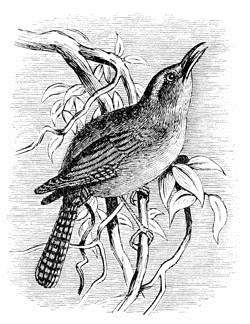
Thryothorus bewickii.
Habits. The Great Carolina or Mocking Wren is found in all the Southeastern and Southern States from Florida to Maryland, and from the Atlantic to Kansas and the Valley of the Rio Grande. It is not common about Washington, but is much more abundant in the Southern States. Occasionally it has been found as far north as Philadelphia, and in one or two instances near New York, where Mr. Lawrence has twice seen it, and where on one occasion it appeared to be breeding. Dr. Woodhouse found it very abundant throughout Texas and the Indian Territory. It is also abundant, and resident, in Southern Illinois, as far north as latitude 38° 20′ 20″.
The habits and movements of this species, as described by those who have had the best opportunities for observing it, correspond with those of the whole family of Wrens. Its flight is usually only in short distances, and is accompanied with short flappings of the wings, and violent jerkings of the body and the tail. The latter is usually kept erect. It moves with quick jerks, and with sharp, rapid notes uttered as if in anger. It is in sight one moment and out the next, passes in at one place and out at another with the rapidity of thought. Mr. Audubon often saw it singing from the roof of an abandoned flat-boat, near New Orleans, and when its song was ended it would creep from one board to the next, enter an augur-hole at one place to reappear at another, catching numerous spiders and other insects all the while.
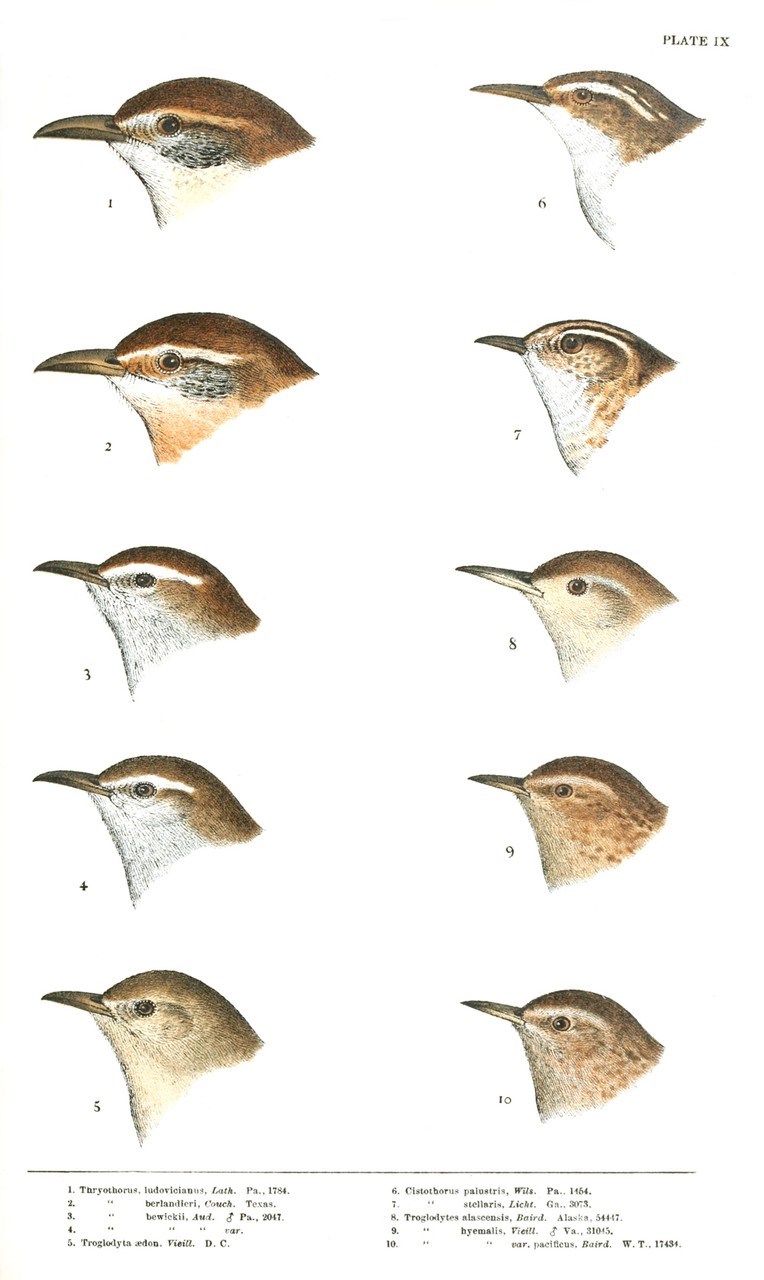
PLATE IX.

1. Thryothorus ludovicianus, Lath. Pa., 1784.
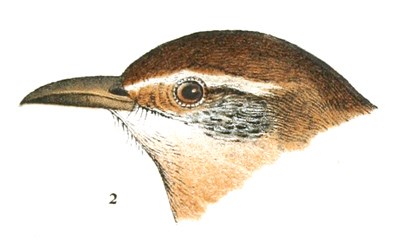
2. Thryothorus berlandieri, Couch. Texas.
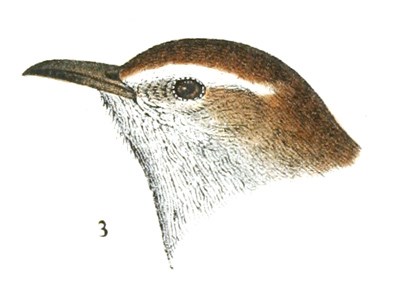
3. Thryothorus bewickii, Aud. ♂ Pa., 2047.
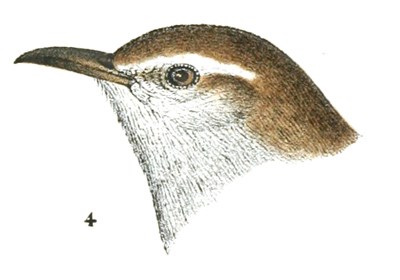
4. Thryothorus bewickii, Aud. var.
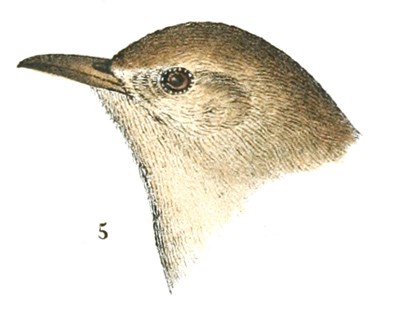
5. Troglodyta ædon, Vieill. D. C.

6. Cistothorus palustris, Wils. Pa., 1454.
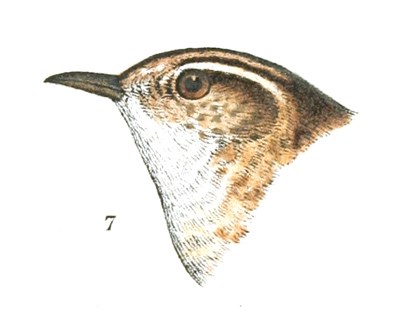
7. Cistothorus stellaris, Licht. Ga., 3073.
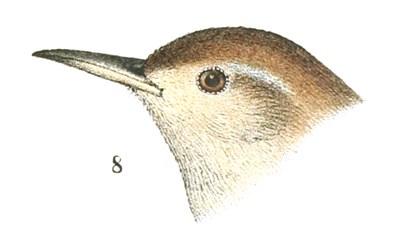
8. Troglodytes alascensis, Baird. Alaska, 54447.

9. Troglodytes hyemalis, Vieill. ♂ Va., 31045.
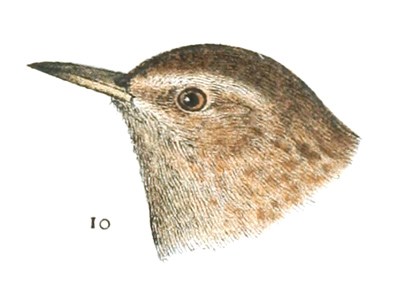
10. Troglodytes hyemalis var. pacificus, Baird. W. T., 17434.
Occasionally its movements are like those of a Creeper, ascending to the upper branches of trees of a moderate height, or climbing a grapevine, searching diligently among the leaves and in the crevices of the bark for insects.
This species possesses a great variety and power of song. It is also said to have and to exhibit remarkable powers of imitation, with a great variety in its appropriated notes of other birds, giving, with modulations, the hoarse rattle of the Kingfisher, the lively notes of the Tufted Titmouse, the simple refrain of the Ground Robin, with those of the Grakles, the Meadow Lark, the Bluebird, and others. Like the common Wren, the Carolina generally builds its nest in the hollow of some tree or stump, or any other convenient cavity. At other times it constructs its own habitation without any other protection than the thick branches of a vine or shrub. In these situations they are long and deep, and have an artificial roofing, often separate from the nest itself. The materials employed in their construction are hay, grasses, leaves, feathers, horse-hair, and dry fibres of the long Spanish moss. They are softly and warmly lined with fur, hair, and feathers. The nest is not unfrequently five or six inches in depth, while the opening is not large enough to admit more than one bird at a time. They sometimes raise three broods in a season.
It breeds as far north as Philadelphia, Mr. Audubon having found its nest in a swamp in New Jersey, opposite that city.
Although seemingly studious of concealment, and shy and retiring in its habits, Nuttall frequently observed it in Tuscaloosa and other large towns in Alabama, appearing on the tops of barns and out-houses, singing with great energy.
Dr. Cooper, who enjoyed a favorable opportunity of watching these birds in Florida, in the spring and summer of 1859, found a nest of this Wren in the middle of March. It was built in a small box on a shelf in a mill, and was about four feet from the ground. It was arched over at the top, though this was not necessary to shelter it. This covering was formed of shavings, with a few small sticks and straws. Four eggs were laid. The birds were very tame, and were not alarmed by the loud noise of the mill, nor by a cat almost always present. Another nest found by Dr. Cooper was built in a small hole in the trunk of a tree, not more than six inches from the ground. This nest was not arched over. Its close proximity to a dwelling-house alone protected it from wild animals.
The eggs of this Wren are usually six or seven in number, and vary in size and shape. They are for the most part of a spheroidal-oval shape, though some are more oblong than others. Their length varies from .75 to .70 of an inch, and their greatest breadth from .60 to .65. The ground-color is a reddish-white, profusely covered with blotches of purple, slate, reddish-brown, and red. These are generally and pretty equally diffused, and are not more abundant at the larger end than elsewhere.
Thryothorus ludovicianus, var. berlandieri, CouchBERLANDIER’S WRENThryothorus berlandieri, Couch, Baird, Birds N. Am. 1858, 362, pl. lxxxiii, fig. 1 (New Leon); Rev. 124.
Sp. Char. Exposed portion of bill nearly as long as the head. Above dark rusty-brown, most vivid on the rump. A whitish streak over the eye, bordered above with brown. Chin white; rest of under parts dark brownish-red; the under tail-coverts and sides of the body barred with dusky. Exposed surface of wings and tail barred throughout with dusky. Legs flesh-color. Length, 5.25; wing, 2.25; tail, 2.12.
Hab. Valley of Rio Grande.
The distinctive features of this race will be found indicated on page 141. This form bears to the T. ludovicianus about the same relation that Harporhynchus longirostris does to H. rufus; and is hardly to be considered a distinct “species” from it. It should be noted that in both cases the lengthened bill and deeper color belong to the Rio Grande. It has not yet been met with north of the Rio Grande, but doubtless extends into Texas. Nothing is known of its habits.
Subgenus THRYOMANES, SclatThryomanes, Sclater, Catal. Am. Birds, 1861, 21. (Type Troglodytes bewickii.)
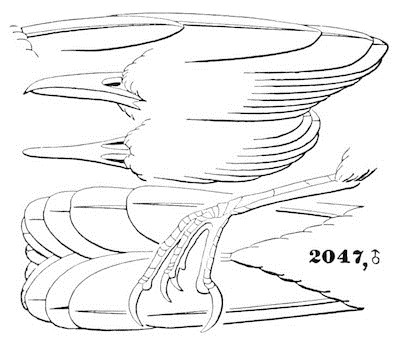
Thryothorus bewickii.
2047, ♂
There are three strongly marked geographical varieties of “Bewick’s Wren,” separable by quite constant characters. Of these the Mexican (leucogaster) and the typical form from eastern North America (bewickii) differ most in coloration, while the western (spilurus) is intermediate in this respect, but with a longer bill than in the other two. The peculiarities of the three forms are expressed on page 141.
Thryothorus bewickii, var. bewickii, BonapBEWICK’S WREN; LONG-TAILED HOUSE WRENTroglodytes bewickii, Aud. Orn. Biog. I, 1831, 96, pl. xviii.—Ib. Birds Am. II, 1841, 120, pl. cxviii. Thryothorus bewickii, Bonap. List, 1838.—Baird, Birds N. Am. 1858, 363. Telmatodytes bewickii, Cab. Mus. Hein. I, 1850, 78. Thryothorus bewickii, var. bewickii, Baird, Rev. Am. B. 1864, 126.
Sp. Char. Above dark rufous-brown; rump and middle tail-feathers sometimes a little paler, and very slightly tinged with gray, and together with the exposed surface of secondaries distinctly barred with dusky. Beneath soiled plumbeous-whitish; flanks brown. Crissum banded; ground-color of quills and tail-feathers brownish-black. Length, 5.50; wing, 2.25; tail, 2.50. Length from nostril, 39; along gape, 70.
Hab. Eastern Province of United States.
Habits. This interesting species of Wren was first met with by Audubon in Louisiana. A number of individuals were observed at the time, but nothing of its history was known for several years afterward. In shape, color, and habits it most resembled the Carolina Wren, but was less rapid in movement, and not so lively. Fourteen years later Dr. Bachman again met with birds of this species, in 1835, at the Salt Sulphur Springs of Virginia. They comprised a family of two parents and five young, nearly full grown. Their notes were like those of the Winter Wren, neither louder nor more connected. They seemed of restless habit, creeping actively among fences, stumps, and logs. One ascended an oak, nearly to the top, in the manner of a Creeper. This species proved to be quite common in that locality, and to be the only Wren abundant among the mountains. Dr. Gibbs detected it near Columbia, S. C., and Dr. Trudeau afterwards found it quite common in Louisiana.
It was first observed breeding by Professor Baird in Carlisle, Penn., in 1844. In all respects the nests and their location corresponded with those of the common Wren. Dr. Woodhouse found it very abundant in the Indian Territory, and describes its habits as similar to those of other Wrens. Lieutenant Couch observed this Wren at Santa Rosalio in Mexico, early in March. It was seeking its food among the low prickly-pears. He was informed that they deposited their eggs wherever they could do so without making much of a nest, inside the cabins under the rafters, but in New Leon he found one of its nests quite elaborately constructed in a thatched roof. He describes the song as quite varied, and one of the sweetest that he heard in that country.
The late Dr. Gerhardt of Varnell’s Station, Ga., met with this species among the mountainous portions of Northern Georgia, where it generally nested in holes in stumps. In one instance the nest was constructed five inches in length, and four in diameter, with a cavity two inches in depth, and the walls of great proportionate thickness, made externally of coarse roots, finer on the inside, and lined with various kinds of animal fur and with feathers. Both birds worked together in constructing their nest, beginning on the 11th of April, and on the 27th of the same month this contained seven eggs. The nest was not covered at the top, in the manner of the Carolina Wren. In the following season another pair commenced building their nest in his bed, in a log-house. Driven from these impossible quarters, they tried the same experiment in various other parts of the house, but only to abandon it, and at last finished by making a successful attempt in the hay-loft. Their visits to that portion of Georgia, he informed me, were irregular and only occasional. In 1859 he had not met with any birds of this species for the space of five years.
The eggs measure .67 by .50 of an inch in their average proportions, resembling somewhat those of the Carolina Wren, but having a lighter ground, with fewer and finer markings of slate and reddish-brown. The ground-color is of a pinkish-white.
Mr. A. Boucard obtained specimens of these birds in the winter months, in the State of Oaxaca, Mexico, probably of the var. leucogaster.
We learn from Mr. Ridgway that in Southern Illinois (as far north as latitude 38° 20′ 20″) this Wren is very abundant, and the most familiar species of the family. In certain localities (as in the Valley of the Wabash) it entirely replaces the Troglodytes ædon, the latter being wholly unknown. In its habits it is even more familiar than that species, always preferring the out-buildings, even in large towns, to the neighborhood of the woods, and still further increases its attractions by possessing a charming song, a real song, of sweet notes finely modulated, and uttered, generally, as the bird perches upon a fence or the stable roof, its head thrown back, and its long tail pendent as it sings. The confused, gabbling sputter of T. ædon, uttered as it pauses just for an instant in its restless hopping through the ivy, cannot be compared to the chant of liquid musical notes of this species, which resembles more nearly, both in modulation and power, that of the Song Sparrow (Melospiza melodia), though far superior to it. On ordinary occasions the note of Bewick’s Wren is a soft, low plit, uttered as the bird hops about the fence or stable, its long tail carried upright, and jerked to one side at each hop. In its movements it is altogether more deliberate and less restless than the T. ludovicianus, or Troglodytes ædon, neither of which it much resembles in motion, and still less in notes. The nest of this Wren is usually built about the out-houses, a mortise-hole or some well-concealed corner being generally selected. Old stables and ash-hoppers are especially frequented as nesting-places. Mr. Ridgway found one in the bottom of the conical portion of a quail-net which was hung up in a shed, and another in a piece of stove-pipe which lay horizontally in the garret of a smoke-house; another rested upon a flat board over the door of an out-house, while a fourth was placed behind the weather-boarding of a building. The nest is generally very bulky, though the bulk is regulated to suit the size of the cavity in which the nest is placed. Its materials are usually sticks, straws, coarse feathers, fine chips, etc., exteriorly fastened together with masses of spider’s-webs, the lining being of finer and more downy materials, generally soft spider’s-webs, tow, and especially the downy feathers of barnyard fowls.
Thryothorus bewickii, var. leucogaster, GouldTroglodytes leucogastra, Gould, P. Z. S. 1836, 89 (Tamaulipas).—Bon. Notes Delattre, 1854, 43. ? Thryothorus bewickii, Sclater, P. Z. S. 1859, 372 (Oaxaca). Thryothorus bewickii, var. leucogaster, Baird, Rev. Am. B. 127.
Sp. Char. Above ashy-brown; rump and middle tail-feathers brownish-ash, the former nearly pure ash; without appreciable bars; bars on secondaries obsolete. Beneath, including inside of wing, pure white, with little or no brownish on the sides. Crissum banded; ground-color of the quills and tail-feathers grayish-brown. Size of var. bewickii.
Hab. Southern borders of United States, into Mexico.
Habits. Nothing is on record of the habits of this variety as distinguished from var. bewickii.
Thryothorus bewickii, var. spilurus, VigorsTroglodytes spilurus, Vigors, Zoöl. Beechey’s Voyage, 1839, 18, pl. iv, fig. 1 (California). Thryothorus spilurus, Cooper, Orn. Cal. 1, 1870, 69. Troglodytes bewickii, Newberry, P. R. R. Rept. VI, IV, 1857, 80.—Cooper & Suckley, Ib. XII, II, 1860, 190. Thryothorus bewickii, Sclater, Catal. 1861, 22, No. 141.(in part). Thryothorus bewickii, var. spilurus, Baird, Rev. 126.
Sp. Char. Similar to bewickii in color, the bill considerably longer. Length from nostril, .50, gape, .81, instead of .39 and .70.
Hab. Pacific slope of United States.
Young birds from all the localities differ from adults merely in having the feathers of the throat and breast very narrowly and inconspicuously edged with blackish.
Habits. This variety of Bewick’s Wren is exclusively an inhabitant of the Western coast. According to Dr. Cooper, they abound throughout the wooded parts of California and northward, frequenting the densest forests as well as the open groves. During the winter they were found in the vicinity of Fort Mojave, but left in April, probably for the mountains. They also winter throughout the mild regions towards the coast as far north as Puget Sound. They are known as Mocking-Wrens, though Dr. Cooper thinks they do not really imitate other birds, but rather have a great variety of their own notes, some of which resemble those of other birds and are well calculated to deceive one unaccustomed to them. He was often led to search in vain for some new form, which he thought he heard singing, only to find it to be a bird of this species. Near San Diego, in April, 1862, he discovered one of its nests built in a low bush, only three feet from the ground. It was quite open above, formed of twigs, grass, etc., and contained five eggs just ready to hatch, described as white with brown specks near the larger end.
Messrs. Nuttall and Townsend observed these birds in the marshy meadows of the Wahlamet, accompanied by their young, as early as May. They seemed to have all the habits of Marsh Wrens. Drs. Gambel and Heermann, who observed them in California, describe them as keeping in low bushes and piles of brush, as well as about old dead trees and logs, over and around which they were flitting with the greatest activity, uttering, when approached, the usual grating scold of the Wrens.
In Washington Territory Dr. Cooper states that this and the Winter Wren are among the few birds that enliven the long rainy season with their songs, which were as constantly heard in the dullest weather as in the sunny spring. The young broods make their first appearance there in June. Dr. Suckley found this species very abundant at Puget Sound, where it is a constant resident throughout the year. On sunny days in January and in February it was found among low thickets in company with the smaller species. At this season they were very tame, allowing a person to approach them without apparent fear. He speaks of the voice of the male as being harsh and loud during the breeding-season, and not unlike that of the common House Wren.




